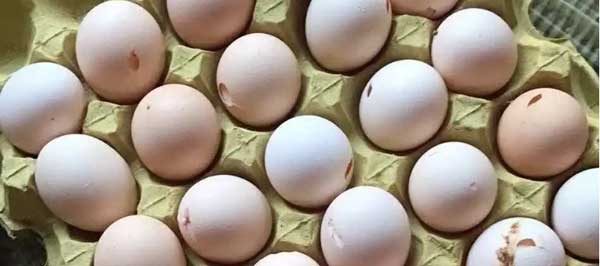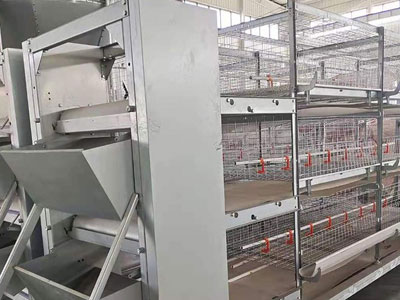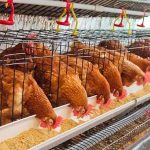Causes of Thin Eggshells
Physiological Factors
Continuous Egg Production: Hens that lay eggs continuously for an extended period are prone to a decline in physiological functions, often resulting in thin or soft eggshells. To ensure normal egg production in the flock, it is essential to improve feed quality, increase animal protein in the diet, provide sunlight exposure, and enhance management practices to help hens quickly recover their physiological functions.
Genetic Factors: Different chicken breeds have varying eggshell qualities. Indigenous chicken breeds tend to have thicker eggshells, while exotic breeds may have thinner ones, which are more susceptible to breakage. Selective breeding can be employed to improve eggshell thickness in specific breeds and reduce egg breakage rates.
Egg Production Timing: Typically, chickens are fed around 8 AM in chicken farms. During the daytime, blood calcium levels are higher, ensuring sufficient calcium secretion during egg formation, resulting in thicker eggshells for afternoon-laid eggs. In contrast, eggs laid before 10 AM are generally formed overnight when hens are at rest and have lower calcium levels, leading to thinner eggshells in the morning.
Age Influence: Older hens tend to lay larger eggs, but the corresponding eggshells may be thinner. Therefore, it is advisable to keep laying hens for approximately 2 years.
Thyroid Dysfunction: Imbalances in the chicken’s thyroid function can seriously affect calcium absorption and utilization, leading to thin or soft eggshells. Feeding thyroid hormone tablets for 3-5 days can quickly harden eggshells.
Molting: During the molting period, hens undergo significant physiological changes that can result in thinner eggshells and increased egg breakage. Providing whole-grain barley for free feeding for 3-5 days during molting can accelerate the process, helping hens recover quickly and improve eggshell quality.

Management Factors
Poor Ventilation: Inadequate ventilation in battery cages for laying hens can lead to elevated ammonia levels, causing respiratory ammonia toxicity, which results in chickens losing more carbon dioxide. This shortage of carbonate ions affects calcium absorption, leading to thin eggshells. Therefore, proper ventilation and timely removal of manure are essential in battery cages for laying hens to prevent high ammonia concentrations.
Temperature: Both excessively high and low temperatures can affect eggshell quality. When the temperature exceeds 32°C, chickens have difficulty dissipating heat, leading to reduced appetite and decreased feed intake. Prolonged high temperatures can disrupt the chicken’s nutritional balance, lower thyroid function, and reduce calcium levels, resulting in thin or soft eggshells. When the temperature drops below -12°C, chicken feed intake decreases, leading to thinner eggshells. Therefore, it is crucial to provide ventilation and cooling in summer and protect against cold in winter, maintaining temperatures between 15°C and 25°C inside battery cages for laying hens. Additionally, adjusting the concentration of energy, minerals, and proteins in the daily diet based on the season can improve egg production rates and eggshell quality. Adding 0.5%-1.5% baking soda to the feed can increase eggshell strength and significantly reduce thin or soft eggshells. In winter, adding 0.5%-1.0% chili powder to the diet can provide warmth to the chickens, enhance cold resistance, and increase heating.
Feed-Related Factors
Calcium Deficiency: Laying hens require a significant amount of calcium to form eggshells. A calcium deficiency in the diet can result in thin or soft eggshells. Chickens typically consume 50-70 grams of feed per day, and their calcium utilization rate from the feed is only about 60%. Therefore, it is necessary to add 3%-4% calcium carbonate or oyster shell powder to the chicken’s supplementary diet to compensate for the deficiency.
Lack of Vitamin D: Even if the diet is rich in calcium and phosphorus, a deficiency of vitamin D can disrupt calcium and phosphorus absorption and metabolism, leading to small, malformed, thin, or soft eggs, decreased egg production, and reduced hatching rates. Therefore, the most economical and effective way to obtain vitamin D is to allow chickens to get plenty of sunlight, which converts 7-dehydrocholesterol in the skin and feathers into vitamin D3 through UV radiation. In production, vitamin D3 is generally added to the diet. Using fish oil as a supplement for vitamin D in the diet and a treatment for vitamin D deficiency can yield satisfactory results.
Phosphorus Deficiency: Phosphorus plays a vital role in the formation of chicken bones, eggshells, body cells, and the utilization of carbohydrates, fats, and calcium. Hens, in particular, require more phosphorus because egg yolks contain higher levels. The dietary requirement for phosphorus in chicken feed is 0.6%, with an effective phosphorus content of 0.5%. Therefore, it is necessary to add 1%-2% bone meal or calcium phosphate to the diet to supplement the calcium and phosphorus deficiency.
Inappropriate Calcium-Phosphorus Ratio: An improper balance of calcium and phosphorus, either with too much calcium or too much phosphorus, can adversely affect chicken health, growth, egg production, and eggshell quality. The ideal calcium-phosphorus ratio in the diet is generally 6-8:1. An imbalanced ratio can result in thin or soft eggshells. Since calcium deposition in eggshells mainly occurs in the evening, extending the feeding time in the evening is advisable. Therefore, feeding crushed eggshells or bone meal in the evening can improve eggshell quality.
Moldy Feed: Improper storage of feed can lead to mold growth, which can harm the liver and kidneys of chickens due to aflatoxin contamination. This can disrupt the metabolism of vitamin D in chickens, leading to reduced body weight, lower feed efficiency, decreased disease resistance, reduced egg production, and soft eggshells. Therefore, feed should be properly stored to prevent moisture and mold growth.
Improper Use of Additives: Properly using additives can improve egg production rates and eggshell quality. However, the composition of feed additives varies widely in China. Therefore, it is essential to select suitable additives based on the specific circumstances of the chicken flock and carefully control their usage.


Ten Tips for High Egg Production
- Pine Needle Feeding Method: Pine needles are not only nutritious but also contain natural antimicrobial substances that promote livestock and poultry growth, prevent gastrointestinal diseases, and address various vitamin deficiencies. Data suggests that adding 6% pine needle powder to chicken feed can increase egg production rates by approximately 13%.
- Vegetable Oilcake Feeding Method: Adding 7% cooked (or detoxified) vegetable oilcake to the diet of laying hens can increase egg production rates by around 10%.
- Peanut Shell Powder Feeding Method: Incorporating 3%-5% peanut shell powder into the diet of laying hens can increase egg production rates by approximately 15%.
- Coix Seed Cake Feeding Method: Coix seed cake is a byproduct of coix fruit oil extraction, containing crude protein (39%) and trace sedative substances. Adding 10% coix seed cake powder to the basic diet of laying hens can increase egg production rates by approximately 8%.
- Carrot Feeding Method: Carrots are rich in carotene, various B vitamins, and trace elements. Adding 10%-20% carrots to the diet of laying hens can increase egg production rates.
- Corn Pollen Feeding Method: Mixing corn pollen into the feed can increase egg production rates by about 10%, resulting in bright eggshells and increased yolk volume.
- Celery Feeding Method: Feeding fresh celery to chickens can enhance egg production rates. Celery leaves can be fed separately, and chopped celery stems can be mixed with supplementary feed at a rate of approximately 50 grams per chicken per feeding, three times a week.
- Snail Feeding Method: Including 5% snails in the diet of laying hens can increase egg production rates.
- Eggshell Feeding Method: Regularly adding crushed eggshells to the feed can increase egg production rates.
- Honey Feeding Method: Feeding each chicken 1 gram of honey per day (diluted in water and mixed into the feed twice a day) can boost egg production rates.



